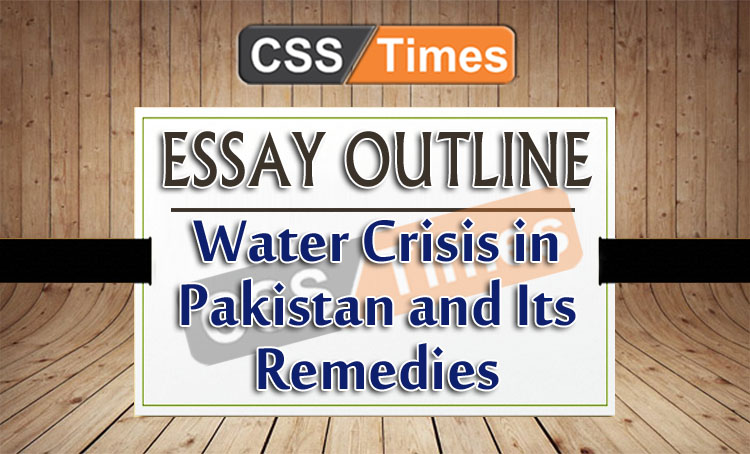Essay Outline: Water Crisis in Pakistan and Its Remedies
World Bank (WB) and Asian Development Bank (ADB) report
Causes of water crisis
• No dams construction
• Dispute between the provinces
• Demands of Sindh
• Punjab’s role
• Lack of proper water management
• Climate change
• Mismanagement of resources
Indian propaganda since 1947
• Standstill Agreement
• Role of the president of the World Bank
• Indus Basin Treaty 1960
• Wullar Barrage (The Tulbal Navigation Lock)
• Kishanganga Project
• Baghlihar Dam
Sources of water
• Indus River
• Closed basin Kharan desert
• Makran coastal basin
• Water reservoirs I capacities
• Terbela dam reservoir
• Mangla dam reservoir
• Chashma barrage reservoir
• Utilisation of water
• Irrigation
• Power generation
• Drinking
• Industry
Water and agriculture
Impact on economy
Recommendations
• Chasha dam
• Kalabagh dam
• Thal Reservoir
• Raised Mangla dam
• Mirani dam
• Gomalzam dam
• Water management
• Use of alternative sources of energy
Conclusion
Essay Introduction: Water Crisis in Pakistan and Its Remedies
According to the World Bank (WB) and Asian Development Bank (ADB), Pakistan is one of the most “water stressed” countries in the world; it is likely to face an acute water shortage over the next five years due to lack of water availability for irrigation, industry and human consumption. A WB report states that water supply in Pakistan has fallen from 5,000 cubic meters per capita to 1,000 cubic meters in 2010, and is likely to further reduce to 800 cubic meters per capita by 2020. Contributory factors consist of increase in population, climate change, lack of a solid vision to construct water reservoirs, and misplaced use of Jhelum and Chenab rivers by India under the Indus Water Treaty (IWT) of 1960 that has resulted in reduced flow of water to Pakistan. The water crisis has two dimensions. First is the distribution of water among the four provinces, particularly between Punjab and Sindh. The second is between Pakistan and India arising because of utilizing water from Chenab and Jhelum rivers. The first problem basically arises from the second one.
India got the right to fully utilize water from the three eastern rivers; Ravi, Bias and Sutlej, while Pakistan was to utilize water from the three western rivers; Indus, Chenab and Jhelum under the Indus Water Treaty (IWT). India was also permitted limited irrigation of 1.343 million acres (2.85 MAF) from western rivers. Water for Pakistan was not quantified. However, it is implied in the treaty that India is not to exceed the specified limit for water utilization. If India continues with its current strategy of building dams on Chenab and Jhelum rivers, then there would be serious implications for Pakistan’s agriculture and national security. It would aggravate the already strained relationship between the two countries, which is due to the unresolved Kashmir issue. A very strong perception exists in Pakistan that India in its quest to utilize water from Chenab and Jhelum rivers and is not fulfilling its obligations under the IWT. It wants to constrict the flow of water to Pakistan. This strategy has a hidden political agenda to create scarcity of irrigation water that would hurt Pakistan’s economy and agriculture sector in between 10-15 years. The national interests of both the countries would be best served (India honoured its comn1itrnents under the IWT. But, is India ready to address Pakistan’s concerns or wants to safeguard its own interests by violating the IWT that could lead to worsening of relations between the two countries?

One reply on “Essay Outline: Water Crisis in Pakistan and Its Remedies (CSS-2016)”
incomplete